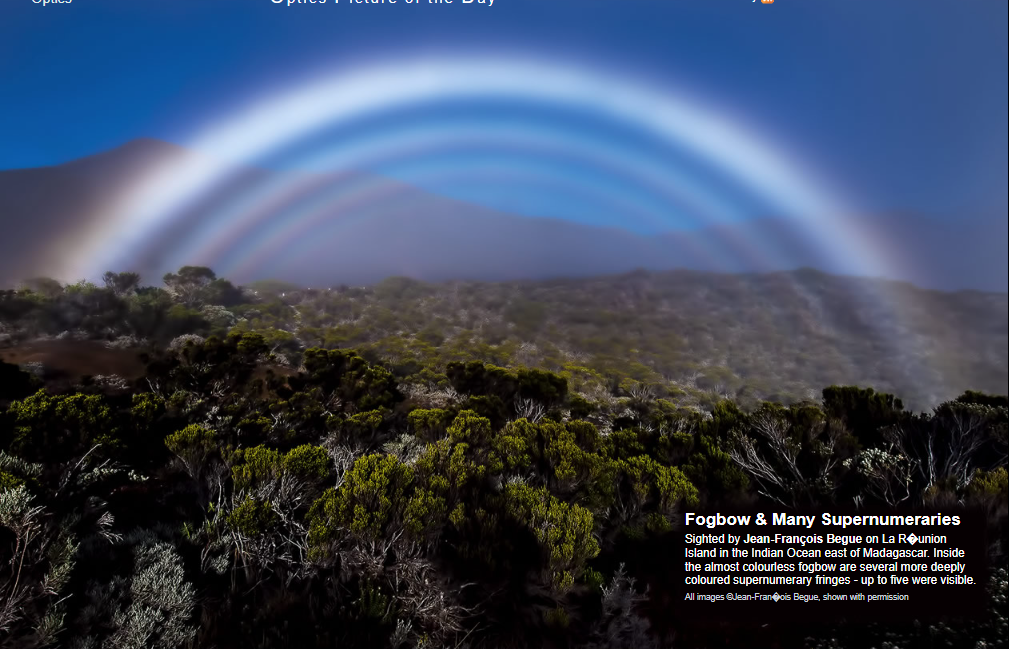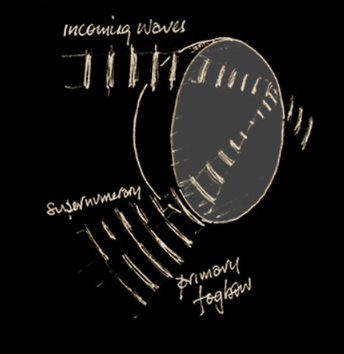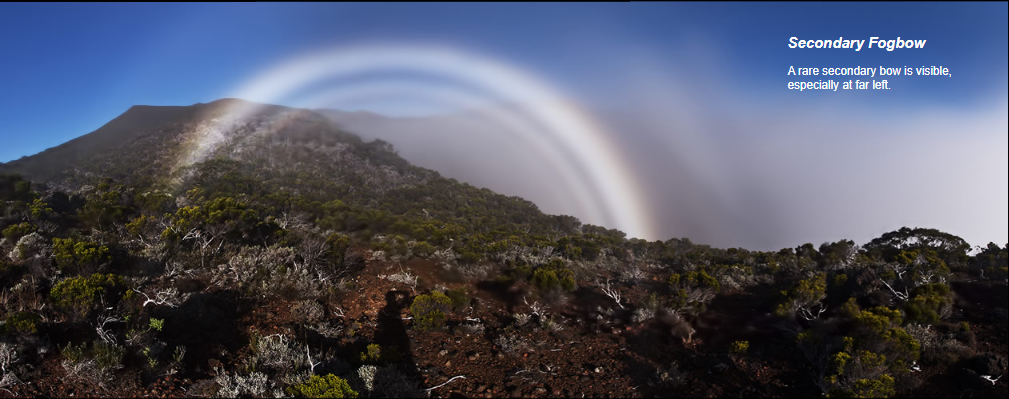Fogbow Reunion Island - OPOD
Fogbow Reunion Island - A Spectacular Display of Atmospheric Optics
Have you ever witnessed a fogbow? If not, let me take you on a journey to the mesmerizing La Réunion Island in the Indian Ocean, where Jean-François Begue captured a breathtaking sight of a fogbow and its accompanying supernumerary fringes. In this article, we will delve into the fascinating world of fogbows and explore the science behind this captivating atmospheric phenomenon.
The Enigmatic Fogbow
Similar to rainbows, fogbows are formed when sunlight interacts with water droplets. However, there is a key difference: while rainbows are created by larger raindrops, fogbows arise from smaller fog droplets. These tiny droplets, ranging from 0.01 to 0.2mm in diameter, are only about 10-100 times the size of visible light wavelengths. As a result, wave effects play a significant role in the formation of fogbows.
When sunlight enters a water droplet, it undergoes scattering and diffraction due to the small size of the droplets. The scattered waves overlap and interfere with each other, leading to a broad and diffuse circle of light instead of the distinct and vibrant colors seen in rainbows. This is why fogbows appear almost colorless compared to their rainbow counterparts.
Supernumerary Fringes - A Spectacular Sight
One of the most captivating features of the fogbow captured on La Réunion Island are the supernumerary fringes. These deeply colored fringes can be seen within the fogbow itself, adding an extra layer of visual intrigue. To understand their formation, we need to explore the interplay between ray optics and wave optics.
When sunlight passes through a water droplet, there are two possible ray paths it can take. Each of these paths can be thought of as carrying waves, and these waves have different path lengths. When they overlap and interfere with each other, some directions reinforce the waves, while in other directions, the waves cancel each other out. This interference pattern gives rise to the supernumerary fringes observed within the fogbow.
The spacing of these fringes is dependent on the size of the water droplets. In the case of the fogbow on La Réunion Island, the droplets must have been closely similar in size, allowing the supernumerary fringes to be clearly visible.
A Glimpse of the Secondary Fogbow
In addition to the primary fogbow, Jean-François Begue also captured a rare secondary bow in his photographs. This secondary bow can be seen at the far left of the image, adding another layer of wonder to this already extraordinary display of atmospheric optics. While secondary bows are less common than primary bows, their presence further enhances the beauty and complexity of the scene.
Exploring Atmospheric Optics
The fogbow on La Réunion Island serves as a reminder of the incredible diversity and complexity of atmospheric optics. From rainbows to fogbows, these optical phenomena offer us a glimpse into the intricate interplay between light and water droplets in our atmosphere.
Next time you find yourself in a foggy environment, keep an eye out for these ethereal circles of light. You may be fortunate enough to witness the enchanting dance of supernumerary fringes within a fogbow, creating a spectacle that will leave you in awe of the wonders of nature.

Fogbow & Many Supernumeraries
Sighted by Jean-François Begue on La R�union Island in the Indian Ocean east of Madagascar. Inside the almost colourless fogbow are several more deeply coloured supernumerary fringes - up to five were visible.
All images ©Jean-Fran�ois Begue, shown with permission

Fogbows
Sunlight making a fogbow follows the same recipe as that for a rainbow. Light enters a water sphere, reflects once from the opposite side and leaves in several directions almost back towards the sun. The difference is that large (1-2mm diameter) raindrops give rainbows while small fog droplets (0.01 - 0.2mm diameter) produce fogbows.
The smaller droplets are only 10-100 times the size of wavelengths of visible light and wave effects are therefore significant. At each surface the light waves are scattered in many directions and these outgoing scattered waves overlap and interfere - in other parlance they are diffracted. The result is a broad and diffuse circle of light rather than the sharper rainbow. However, rainbows themselves are not innocent of diffraction effects - witness their supernumerary fringes.
Supernumerary fringes
Mixing (badly!) ray and wave optics, for any one deflection angle there are two possible ray paths through the drop. Now think of each of those ray paths as carrying waves. The two waves have different path lengths. When they overlap and interfere some directions reinforce, in others the waves cancel. The result - supernumerary fringes.
The fringe spacing depends on droplet size and when there is a range of sizes the fringes get washed out. here the droplets must have had closely similar sizes.

Secondary Fogbow
A rare secondary bow is visible, especially at far left.
Note: this article has been automatically converted from the old site and may not appear as intended. You can find the original article here.
Reference Atmospheric Optics
If you use any of the definitions, information, or data presented on Atmospheric Optics, please copy the link or reference below to properly credit us as the reference source. Thank you!
-
<a href="https://atoptics.co.uk/blog/fogbow-reunion-island-opod/">Fogbow Reunion Island - OPOD</a>
-
"Fogbow Reunion Island - OPOD". Atmospheric Optics. Accessed on November 26, 2024. https://atoptics.co.uk/blog/fogbow-reunion-island-opod/.
-
"Fogbow Reunion Island - OPOD". Atmospheric Optics, https://atoptics.co.uk/blog/fogbow-reunion-island-opod/. Accessed 26 November, 2024
-
Fogbow Reunion Island - OPOD. Atmospheric Optics. Retrieved from https://atoptics.co.uk/blog/fogbow-reunion-island-opod/.